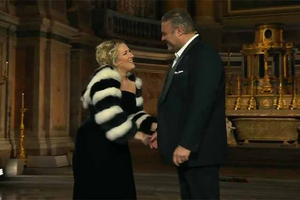Review: Damrau Goes for Broke, Calleja Plays It Safer in 'Met Stars Live in Concert' from Italy
The latest in the Met's series of live international concerts

the chapel of the Royal Palace of Caserta
In the latest installment of the Met Stars in Concert Series, soprano Diana Damrau and tenor Joseph Calleja took center stage in the Royal Palace of Caserta in Italy, a UNESCO World Heritage site, with the grand assistance of pianist Roberto Moresco.
The performing space--the palace's spectacular Palatine Chapel--is neoclassically elegant, combining Renaissance, manneristic and baroque traditions, consecrated on Christmas Day 1784, with a wood-coffered, barrel-vaulted ceiling.
So much for the architecture: What about the music?
Damrau's program was filled with music (mostly) from roles she hasn't sung on stage. Will she ever sing Floria Tosca, Micaela in CARMEN, or the title role of SEMIRAMIDE at the Met? I wouldn't hold my breath. Yet it was a pleasure to hear this consummate artist dip her feet into different kinds of water.
She began with Tosca's entrance into the Church of Sant'Andrea della Valle ("Mario! Mario!"), where her lover, Cavaradossi (Calleja) is painting a portrait of the Virgin. The heavily ornate room is more like the audience-pleasing Zeffirelli take on the scenic design than the current version at the Met by David McVicar.
The two singers sound surprisingly good together considering the differences in their voices. (They also seem to enjoy each other's company.) Damrau's Tosca is a bit smaller in scale than one usually hears in the role, but sounding so fresh voiced in "Vissi d'arte" that it didn't matter, fitting quite nicely into the chapel's acoustics.
Calleja's time to show off his burly voice was with Cavaradossi's show-stopping "E lucevan le stelle." It always amazes me that a piece that is so well known and has so impactful is also so short. It shows, I guess, the mastery of Puccini.
Back to Damrau, the concert also includes an "HD Live" clip from the Met's latest production of LA TRAVIATA, specifically Violetta's deathbed scene. I thought she sounded better here than in the theatre--absolutely superb. I remember interviewing Damrau when she had her role debut as Violetta and she's come a long way since that first cut at it.
It had been a role she lusted after, ever since seeing the Zeffirelli film version starring Teresa Stratas opposite Placido-he-who-shall-not-be-named. She waited a long time to do it, making sure her technique and voice were ready for those "big Verdi lines," as she described it to me. By the time of her debut she found she could "relax and enjoy" herself.
She and Calleja shared the duet from L'ELISIR D'AMORE, "Una parola o Adina...Chiede all-aura lusinghiera," and Damrau, for one, seemed to adore the role, particularly this aria. Would she ever sing it again at the Met, post-COVID, of course? You never know--after all, Netrebko sang it in the house when her voice had already grown to Wagner proportions. I also wouldn't mind hearing her in Rossini's SEMIRAMIDE, judging by her "Bel raggio lusinghier," if the rest of the opera fits her as well as this aria.
As for Calleja, his voice seemed a little big for Nemorino; especially after hearing people like Pavarotti, Florez and, most recently, Camarena with their sweet tones sounding so lovely in the role.
He was better suited to Don Jose in the excerpts from CARMEN and "Ma se m'e forza perderti" from BALLO IN MASCHERA. His voice gets a little gravelly when he pushes too hard. The change in his voice over the years was especially apparent in the "Live in HD" clip from the Met's production of LUCIA DI LAMMMERMOOR opposite Natalie Dessay. He sang Edgardo's final aria gorgeously--his voice much lighter than it is today; his current vocal state simply can't compete with it.
The duo ended the concert with some lighter fare. I was particularly smitten with Damrau's take on "Hore ich Zigeunergeigen," from Emmerich Kalman's operetta GRAFIN MARITZA. It's a juicy aria that she clearly adores singing--play on Gypsies! For Calleja, it was the lovely, upbeat "Granada" by Agustin Lara that did the trick for me. Together, they excelled in "Non ti scordar di me" by Ernesto De Curtis, a song that can be done by a variety of voices (and, with Pavarotti, an accompanying flute)
The concert ended with Damrau and Calleja singing the Bach/Gounod "Ave Maria"--a prayer for things to return to normalcy, beautifully modulated and poignant on so many levels.
The concert is available through the Met's website through November 6 and well-worth the $20 price of admission.
The Program
"Mario! Mario!" (TOSCA)
"E lucevan le stelle" (TOSCA)
"Vissi d'arte" (TOSCA)
"Una parola, o Adina ... Chiedi all'aura lusinghiera" (L'ELISIR D'AMORE)
"Ma se m'è forza perderti" (BALLO)
"Bel raggio lusinghier" (SEMIRAMIDE)
"La fleur que tu m'avais jetée" (CARMEN)
"Parle-moi de ma mère" (CARMEN)
"Höre ich Zigeunergeigen" (GRAFIN MARIZA)
"Granada" by Agustín Lara
"Non ti scordar di me" by Ernesto De Curtis
"Ave Maria" by Johann Sebastian Bach/Charles Gounod
Reader Reviews
Videos

